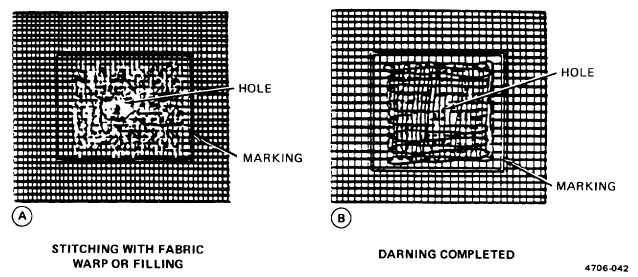ARMY TM 10-1670-275-23&P
AIR FORCE TO 13C5-25-2
NAVY NAVAIR 13-1-26
2-17.
Repair - Sewing Procedures (cont).
(2) Other parachute Items. Stitching and restitching on other parachute items constructed from cloth,
canvas, and webbing should be accomplished with thread which matches the color of the original stitching,
when possible. All straight stitching should be locked by backstitching at least 112 inch. Restitching should be
locked by overstitching each end of the stitch formation by 112 inch. Zigzag stitching does not require locking;
however, zigzag restitching should extend at least 114 inch into undamaged stitching at each end, when
possible. Restitching should be made directly over the original stitching, following the original stitch pattern as
closely as possible:
c. Darning. (Refer to Tables 2-2 and 2-3). Darning is a sewing procedure used to repair limited size
holes, rips, and tears in assorted air delivery items constructed from textile material such as parachute canopy
gore sections. A darning repair may be made either by hand or sewing machine, depending upon the method
preferred and the availability of equipment. However, a darning machine should be used to darn small holes
and tears where fabric is missing. Darning of previously patched material can be performed provided darning
size limitations prescribed in the paragraph applicable to the item are not exceeded. A darning repair will be
performed using the following procedures, as appropriate:
(1) Machine darning. Proceed as follows:
(a) Using an authorized marking aid of contrasting color, mark a square around the damaged area and
ensure that the marking is at least 1/4 inch back from each edge of the damaged area. The marking
will be made with the warp and the filling of the material.
(b) Darn the damaged area by sewing the material in a back-and-forth manner, using size A or E nylon
thread, allowing the stitching to run with the warp or filling of the fabric (A, figure 2-37).
(c) Turn the material and stitch back and forth across the stitching made in (b) above until the hole or
tear is completely darned (A, figure 2-37).
(d) If applicable, re-stencil informational data, gore number(s), or identification marks using the criteria
in paragraph 2-19.
Figure 2-37. Darning Method Using a Darning Sewing Machine.
2-50



